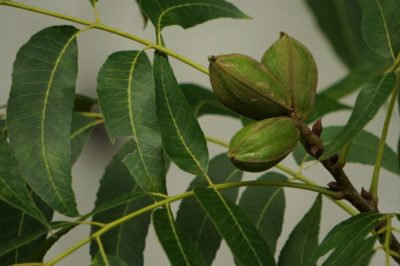Pecan Leaf Appearance
A single pecan leaf is actually made up of nine to 17 leaflets. Between eight and 16 of them line up in opposite pairs along a central stem. The last is the terminal leaflet. Each is lustrous, deep green on top and pale green underneath. When young, it’s matted with fine hairs that shed over time.
From the tip of its terminal leaflet to the base of its stem, a pecan leaf measures between 12 and 20 inches long. Each narrow, lance-shaped leaflet measures from 3 to 8 inches long and curves at the end like a falcon’s beak. It has toothed edges; occasionally, the teeth themselves are toothed.
Expert gardener’s tip: Crushing a pecan leaf releases a strongly aromatic fragrance with hints of:
- Orange
- Black pepper
- Burnt sugar
- Turpentine
Some people find the odor unpleasant.
Pecan Leaf Function
A pecan leaf’s job is fourfold:
- It traps the sunlight’s energy in specialized structures called chloroplasts, which contain green chlorophyll molecules.
- It uses the stored energy to split the hydrogen and oxygen atoms in the water absorbed from the tree’s roots.
- It absorbs carbon dioxide from the atmosphere and combines it with the hydrogen atoms. The tree uses the resulting carbohydrates to fuel its growth, flowering and nut production.
- During the daytime, it releases the leftover oxygen molecules back into the atmosphere.
At night, a pecan leaf inhales oxygen and exhales carbon dioxide just like we do. But the carbon dioxide equals just 10 percent of the oxygen it releases during the day.
The Pecan Leaf as Food
For every person who loves pecan nuts, countless pests are equally fond of pecan leaves. Topping the list are aphids, pinhead-sized insects that latch onto a leaf in bunches to drain its fluids with their needle-sharp mouthparts.
Hickory leaf stem gall phylloxera are aphidlike insects. They irritate a leaf’s tissue enough that it grows galls to envelop them. They remain inside from spring until midsummer, producing several new generations. Eventually the galls blacken, break open and release their captives. Although not disease-related, the galls look alarming.
